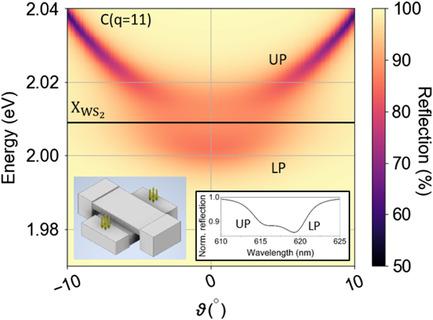当前位置:
X-MOL 学术
›
Phys. Status Solidi. Rapid Res. Lett.
›
论文详情
Our official English website, www.x-mol.net, welcomes your
feedback! (Note: you will need to create a separate account there.)
Tunable Polymer/Air-Bragg Optical Microcavity Configurations for Controllable Light–Matter Interaction Scenarios
Physica Status Solidi-Rapid Research Letters ( IF 2.5 ) Pub Date : 2021-05-22 , DOI: 10.1002/pssr.202100182 Chirag Chandrakant Palekar 1 , Arash Rahimi-Iman 1
Physica Status Solidi-Rapid Research Letters ( IF 2.5 ) Pub Date : 2021-05-22 , DOI: 10.1002/pssr.202100182 Chirag Chandrakant Palekar 1 , Arash Rahimi-Iman 1
Affiliation

|
Complex optical systems such as high-quality microcavities enabled by advanced lithography and processing techniques have paved the way to various light–matter interaction (LMI) studies. Sub-micrometer-precise lithographic development of a polymer photoresist allows construction of microcavity structures for various spectral regions based on the material's transparency and the geometrical sizes. On the other hand, this approach also avoids lattice-matching constraints in epitaxy, complex coating techniques, and shaky open-cavity constructions. Herein, a new approach based on 3D nanowriting in a photoresist is introduced, which can be used to achieve microscopic photonic Fabry–Pérot cavity structures with mechanically tunable resonator modes and polymer/air-Bragg mirrors, directly on a chip or device substrate. By transfer-matrix calculations and computer-assisted modeling, it is demonstrated that open microcavities with up to two “air-Bragg” reflectors comprising alternating polymer/air-mirror-pair layers enable compression-induced mode tuning that can benefit many LMI experiments, such as with 2D materials, nanoparticles, and molecules.
中文翻译:

用于可控光-物质相互作用场景的可调聚合物/空气布拉格光学微腔配置
复杂的光学系统,例如由先进的光刻和加工技术实现的高质量微腔,为各种光-物质相互作用 (LMI) 研究铺平了道路。聚合物光刻胶的亚微米级精密光刻显影允许基于材料的透明度和几何尺寸为各种光谱区域构建微腔结构。另一方面,这种方法还避免了外延、复杂的涂层技术和不稳定的开腔结构中的晶格匹配约束。在此,介绍了一种基于光刻胶中 3D 纳米写入的新方法,该方法可用于直接在芯片或设备基板上实现具有机械可调谐振器模式和聚合物/空气布拉格反射镜的微观光子法布里-珀罗腔结构。
更新日期:2021-07-12
中文翻译:

用于可控光-物质相互作用场景的可调聚合物/空气布拉格光学微腔配置
复杂的光学系统,例如由先进的光刻和加工技术实现的高质量微腔,为各种光-物质相互作用 (LMI) 研究铺平了道路。聚合物光刻胶的亚微米级精密光刻显影允许基于材料的透明度和几何尺寸为各种光谱区域构建微腔结构。另一方面,这种方法还避免了外延、复杂的涂层技术和不稳定的开腔结构中的晶格匹配约束。在此,介绍了一种基于光刻胶中 3D 纳米写入的新方法,该方法可用于直接在芯片或设备基板上实现具有机械可调谐振器模式和聚合物/空气布拉格反射镜的微观光子法布里-珀罗腔结构。









































 京公网安备 11010802027423号
京公网安备 11010802027423号